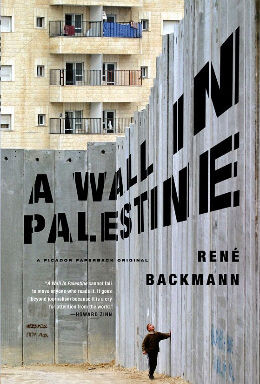The Electronic Intifada 8 October 2010

A Wall in Palestine looks at the planned 490-mile-long, 25-foot-high wall, complete with fencing, trenches, thermal imaging and sniper towers, that Israel is building in parts of the West Bank. While Backmann’s work is a useful contribution to understanding Israel’s wall, the author all too easily adopts the language of the Israeli occupation and spends little time on crucial context and history relating to the conflict.
In 2004, the International Court of Justice (ICJ), in an advisory opinion, ruled the route of the wall was illegal under international law. The vast majority of it snakes through occupied Palestinian territory, slicing up Palestinian villages and cutting off access to urban areas.
The idea of constructing a barrier to separate the Palestinian population from the Israeli population has deep roots within Zionist ideology and has been proposed by Israeli officials for decades. As Backmann explains, the idea of building a wall can be traced, at least in a metaphorical sense, to Vladimir Jabotinsky, the ideological father of Revisionist Zionism, the right-wing strain of Zionism that advocated for a Jewish majority in all of what was Mandate Palestine. Jabotinsky famously wrote in 1923 that “[Jewish] emigration to Palestine must continue … in a way that our settling can develop there under the protection of a power that is not dependent on the local population, under the shelter of a wall of iron that this population can never break down. This must be our political stance regarding the Arab question” (p. 27-28).
But it wasn’t until the beginning of the second Palestinian intifada in September 2000, and the rise to power of former Israeli defense minister Ariel Sharon, that the idea of a wall began to be seriously considered. Ironically, Sharon’s right-wing Likud Party, which has its roots in Revisionist Zionism, was wary of the idea. Likud-party stalwarts feared that a barrier built on the 1949 armistice line demarcating Israel’s unofficial border with the occupied West Bank might create the boundaries for a future Palestinian state and leave Israel’s colonization project in jeopardy, something that right-wing Zionists had no interest in.
Following its 2002 invasion of major West Bank cities dubbed “Operation Defensive Shield,” the Israeli government under Sharon decided to begin building the wall. Although security for Israeli civilians was the stated justification, the route of the wall made clear that it was primarily an annexation project. As the Israeli human rights group B’Tselem explains, “a major aim in setting the route was de facto annexation of land: when the Barrier is completed, some nine percent of the West Bank, containing sixty settlements, will be situated on the western — the ‘Israeli’ — side” (“The Separation Barrier”). Other benefits of the route of the barrier from the Israeli perspective include, as Backmann notes, the taking of fertile land and precluding the possibility of a Palestinian state.
Backmann is at his best when talking to Israeli officials instrumental in the implementation of the wall and to the Palestinians who have had to bear the brunt of its construction. Heartbreaking stories abound in A Wall in Palestine as Palestinians’ human rights are thrown to the wayside by Israel’s barrier. One example Backmann reports on is a 2004 incident in the village of Ras Atiya, where a two-year-old Palestinian with a high fever died after having to take an hour-long detour due to a barrier gate being closed (p. 89).
Problematically, when describing the Sharon government’s siege of the occupied West Bank and Gaza Strip in 2001, Backmann refers to civilian casualties as “collateral damage” (p. 37). On a number of occasions, he refers to the West Bank uncritically and without quotes as Judea-Samaria, which is the biblical term used by Israeli settlers and their right-wing supporters (p. 29, p. 41, p. 156, p. 173). Backmann fails to adequately discuss the 1948 Palestine War that led to the creation of Israel, including the ethnic cleansing of 750,000 Palestinians in what is called the Nakba, or catastrophe. An exploration of the colonial nature of Zionism would help explain why Israel sees no problem with building a wall that tramples on the human rights of Palestinians. Moreover, the use of the Israeli occupation’s language when talking about the West Bank confers legitimacy on Israeli policies of land confiscation, ethnic cleansing and the wanton killing of innocents.
Also missing is an in-depth discussion of the rise of popular resistance movements across the West Bank, which developed in response to the building of the barrier. Places like the village of Bilin, which hosts a protest against the barrier every Friday, have become international symbols of Palestinian resistance. Yet Backmann does not explore the protests against the wall and what they mean in a larger context.
Backmann’s book represents a unique way of exploring the conflict in looking at it solely through the prism of the separation barrier. But the significant shortcomings in the book hinder what could have been an important and defining piece of work on the wall. Readers who want a sharp and critical look at the wall that places it in its proper historical and ideological context will not have their desire met with A Wall in Palestine. It will have to fall to someone else who will, perhaps, build on Backmann’s work without falling into the pitfalls Backmann does.
Alex Kane is a student, journalist and blogger based in New York City. He is a writer for the Indypendent, where a version of this article was originally published, and a frequent contributor to the blog Mondoweiss. His work has also appeared in Salon, The Electronic Intifada, Common Dreams, Palestine Chronicle, Gotham Gazette and Extra! He blogs at (alexbkane.wordpress.com), and can be followed on Twitter (@alexbkane).
Related Links




